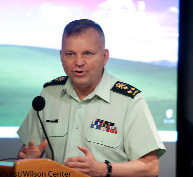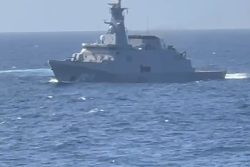WASHINGTON, (Reuters) – This year’s frenzy of oil and gas exploration in newly accessible Arctic waters could be the harbinger of even starker changes to come.

If, as many scientists predict, currently inaccessible sea lanes across the top of the world become navigable in the coming decades, they could redraw global trading routes — and perhaps geopolitics — forever.
This summer will see more human activity in the Arctic than ever before, with oil giant Shell engaged in major exploration and an expected further rise in fishing, tourism and regional shipping. But that, experts warn, brings with it a rising risk of environmental disaster not to mention criminal activity from illegal fishing to smuggling and terrorism.
“By bringing more human activity into the Arctic you bring both the good and the bad,” Lt Gen Walter Semianiw, head of Canada Command and one of Ottawa’s most senior military officers responsible for the Arctic, told an event at Washington DC think tank the Centre For Strategic and International Studies last week. “You will see the change whether you wish to or not.”
With indigenous populations, researchers and military forces reporting the ice receding faster than many had expected, some estimates suggest the polar ice cap might disappear completely during the summer season as soon as 2040, perhaps much earlier.
That could slash the journey time from Europe to Chinese and Japanese ports by well over a week, possibly taking traffic from the southern Suez Canal route. But with many of those key sea routes passing through already disputed waters believed to contain much of the world’s untapped energy reserves, some already fear a rising risk of confrontation.
There are fledging signs of growing cooperation — the first ever meeting of Arctic defence chiefs in Canada later this month, joint tabletop exercises on polar search and rescue operations organised through the Arctic Council. But growing unease is also clear.
Norway and Canada, for example, have spent recent years quietly re-equipping its military and moving troops and other forces to new or enlarged bases further north. Having largely withdrawn most of its forces from the region in the aftermath of the Cold War, officials and experts say the United States is now only just rediscovering its significance.
But for now, Washington has no concrete plans to build even a single new icebreaker — in part because experts estimate the pricetag for a single ship could be as high as $1 billion.
For the first time, some officers worry the United States is losing its foothold as new rivals such as China prepare to muscle in. “We are in many ways an Arctic nation without an Arctic strategy,” United States Coast Guard Vice Adml Brian M Salerno told the same Washington DC event.
“ARCTIC BATTALIONS”
The United States has yet to ratify the United Nations Convention on the Law of the Sea (UNCLOS), which most countries use as the basis for discussing thorny Arctic territorial issues.
Arctic experts point to at least nine separate disputes within the region, from disagreements between the United States and Canada over parts of the Northwest passage to fishing conflicts that also drag in China, Russia, South Korea, Japan and others.
Russia in particular is seen to be keen to assert its presence in a region in which it has long been the dominant power.
It operates almost all of the world’s 34 or so icebreakers — albeit many of them ageing Cold War-era vessels, some powered by nuclear reactors that Western experts say could be a major danger in their own right.
Perhaps just as importantly, its navy continues to view the Arctic as its backyard, vital not just for natural resources essential to maintaining Moscow’s economic clout but also the hiding ground for its ballistic missile-carrying nuclear submarine fleet. But its greatest advantages may be simply demographic.
“They have cities in the Arctic, we only have villages,” says Melissa Bert, U.S. Coast Guard captain and currently a military fellow at the Council on Foreign Relations in New York. “We simply need more of a presence there.”
Western military strategists have long worried that — if economic woes or unrest at home prompted Russia towards a more bellicose foreign policy — it could escalate regional tensions.
Norway and Russia in particular have long had awkward relations over the Svalbard islands, broadly internationally agreed to be Norwegian but with a growing population of Russian emigres.
This year, Oslo announced it was creating a specialist “Arctic battalion”, explicitly linked to a similar move by Russia’s military just across their shared border.
CONFRONTATION OR
COOPERATION?
Some of the most awkward choices, however, will be faced by the Arctic’s least powerful states.
NATO member Iceland raised eyebrows after its 2008 financial implosion when it approached Russia for a bailout, prompting suggestions it might be willing to offer use of a former US airbase and port facilities to Moscow.
Ultimately, it turned instead to the International Monetary Fund and European Union. But similar questions were raised again last year after a Chinese businessman offered to buy a large area of rural Iceland for what he said was a leisure project and golf course.
While he always denied any links to the Chinese government, the sale was ultimately blocked by Icelandic officials citing security concerns.
Greenland, one of Europe’s largest countries but with one of its smallest populations — less than 57,000 people — could face particular challenges.
As its territory opens up more for exploration and mineral extraction, it could find its population swelling rapidly, driven by an influx from Asian investor-countries, notably China.
Nevertheless, some experts believe that if handled properly, the opening of the Arctic could benefit many if not all countries in the northern hemisphere.
“I see the Arctic as ultimately more of a venue for cooperation than confrontation,” says Christian le Miere, senior fellow for maritime affairs at London’s International Institute for Strategic Studies. “China, Northern Europe, Russia will all benefit in particular from the new sea routes. The only real losers will be countries much further south that cannot take advantage.”
For U.S. Coast Guard captain Bert, having spent much of her career in the north, the greatest real enemies remain the vast distances, harsh climate and lack of resources.
Even with the icecaps gone for some of the year, icebergs will still drift through shipping lanes and harsh storms and poor maps provide ever present danger.
“I don’t worry about a war in the Arctic,” she says. “But I do worry that we’re not prepared to deal with a major disaster there. No one is, but as more people go there, it becomes much more likely.”









